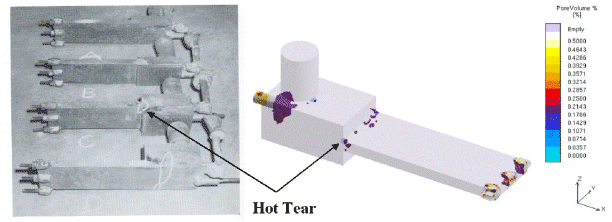Charlie Monroe, Kent Carlson, and C. Beckermann
(sponsored through the Cast Metal Coalition, CMC, by DOE and numerous steel foundries within the Steel Founders' Society of America, SFSA)
Project Fact Sheet from DOE
The Steel Founders Society of America (SFSA) home page can be found here: SFSA
Solidification is a crucial stage in steel casting production. During solidification, contractions or distortions of the steel, known as “dimensional changes,” can cause the final product to vary significantly from the original pattern. Cracks in the casting that form during the late stages of solidification, called “hot tears,” occur when contractions can no longer be accommodated by residual liquid flow or solid displacement. Dimensional changes and hot tears are major problems. These occurrences are difficult to anticipate and correct using traditional foundry engineering methods. While dimensional changes are accommodated using pattern allowances, the desired dimensions are often inaccurate. Castings that form hot tears must then be scrapped or weld repaired, expending unnecessary energy. Correcting either of these problems requires a tedious trial-and-error process that may not necessarily yield accurate results.
Research conducted by the University of Iowa has shown that large dimensional changes are not possible without liquid flowing into or out of a casting section. Hot tears occur along the grain boundaries during the terminal stages of solidification when the stresses developed across adjacent grains exceed the strength of the almost completely solidified steel. Thus, hot tears are initiated in the residual liquid, which are ruptured by contraction stresses. Some successes have been reported in predicting the final dimensions of and residual stresses in castings using stress analysis. However, these models cannot always predict results, in part due to their inability to account for liquid flow. Recently, the researchers developed a model that predicts feeding flow and porosity formation during solidification, but that model assumes the solidified steel to be rigid and immobile. Hence, the occurrence of hot tears cannot be predicted. This project will combine these recently developed stress analysis and feeding flow/porosity models to form a reasonable starting point for a comprehensive, physics-based model of dimensional changes and hot tearing.
The goal of this project is to develop a model to predict dimensional changes and hot tears during solidification of steel castings. The results of this model would be a reduction in scrapped castings and rework/repair due to dimensional changes or hot tears, and also an increase in mold yield due to reduction in the use of padding and improved placement of risers, leading to better riser efficiency.
The objectives of this research are:
- Develop and implement a model into an existing casting simulation code to predict dimensional changes and hot tears during solidification of steel castings,
- Perform a casting experiment to test and validate the model,
- Apply the simulation model to a production casting in a case study illustrating the use of the model in foundry practice.
